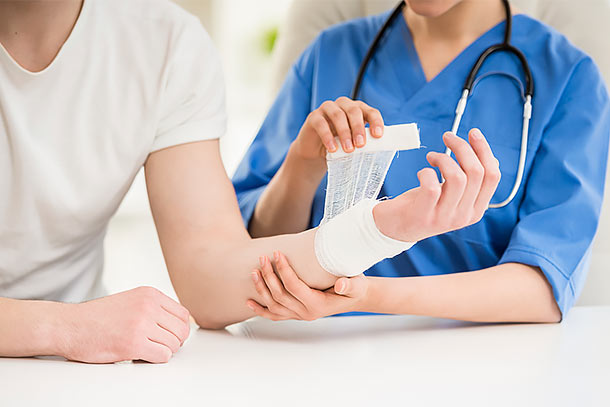Leaving the hospital following an operation or surgery is a good feeling. However, it is important to remember that you will likely need to continue caring for the wound that you received from the operation. For incision and surgical operations, doctors will close your incision with stitches, clips, staples, or skin glue and when you come home from the surgery, it is likely that you will still need to dress the wound.
Dressing and cleaning the wound is necessary in order to protect the wound from germs, reduce the risk of infection, cover the wound, protect the area, and soak up fluids from the wound. Your health provider will give you instructions on when and how to dress your wound, but there are a few things to remember and understand when it comes to cleaning a wound. For example, learning about what type of equipment should be used and how you can promote cleanliness can all help in making wound care after surgery easier.
Caring For The Wound
The first thing to do when preparing to care for a wound after surgery or another operation is to clean your hands. Using a cleanser to wash your hands is important, since it allows you to safely clean your wound and avoid infection. Be sure to take off all your jewelry, wash your hands while cleaning under the nails, rinse well, and dry thoroughly. Similarly, remember to have all your supplies within reach and to have a clean work surface to further sanitary efforts.
You will have to remove the old bandages. Carefully loosen the tape from around the skin, and use a medical glove to remove the old dressing. If the bandages or other items are sticking to the wound, you can wet the area and try again, unless specifically instructed to pull the dressing off while the wound is dry. After taking off the old dressing, clean the hands again.
Finding the right medical and dressing equipment can make these tasks much easier. There’s a wide array of dressing equipment that can all be used for different issues. For example, hydrogel dressings are good for burns, pressure sores, skin tears, and more, while Collagen dressing is used for second-degree burns, pressure ulcers, cuts and other wounds. You can learn more about all the different types of dressings here.
There are many options for compression bandages and adhesive dressings that can help to cover, protect, and treat wounds. Compression bandages can help to reduce pain and swelling in a limb, while adhesive bandages can help to stop the flow of blood and other bodily fluids. Generally, these types of bandages are used to hold dressings in place.
Similarly, gauze pads, wraps, rolls, and sponges can also be great for dealing with post-surgery wounds. There are a number of gauze options, such as non-adherent dressing, which is less likely to stick to the wound. Other options include woven gauze and impregnated gauze, which both provide a moist healing environment that can expedite healing and kill bacteria.
Regardless of the tools you wish to or are instructed to use, dressing the wound properly is the ultimate goal. When dressing the wound, remember to not touch inside the dressing, and do not apply antibiotic cream unless a medical professional tells you otherwise. Be sure that the dressing is secure and all four sides are taped down. After the new dressing is placed, remember to put the old materials from the dressing that you took off in a sealed bag, and dispose of it.
Bathing and Showering
Your doctor will let you know when you can shower and bathe after surgery. Generally, it’s fine to do so once 24 hours have passed since surgery. With that said, there are other options to stay clean and sanitary when you are unable to bathe.
There are many deodorants and body powders that will not only help keep the body clean but can also promote healing. Similarly, there are also products available that can help with dry, scaly skin, bruise relief, and other issues that can be side effects from some of these wounds.
Overall, dressing a wound is important, and the depending on the problem and the type of dressing you choose, you can help to ease pain, encourage healing, absorb excess fluids and blood, prevent infection and further harm, and help to disinfect wounds. Some side effects can occur from dressing a wound or other reasons. If you are experiencing more redness, pain, swelling, or if the wound is looking larger or deeper, reach out to a doctor about what should be done.
Matthew Boyle is the Chief Operating Officer at Landmark Senior Living, a series of top-rated senior living communities in the midwestern United States. He has been working in the healthcare space for 7 years and graduated from Duke University in 2011 Summa Cum Laude. Guided by a relentless pursuit of excellence, Matthew and the team at Landmark are dedicated to creating a supportive environment for the elderly.


